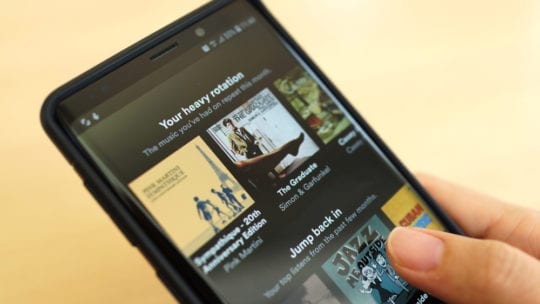
In the public relations world, we're never done debating the evergreen question: "Is the press release dead?" Some communicators answer yes, that the press release has fully transformed into a staggered social outreach strategy, while others save a strong share of their ad spend for email marketing including newsletters, promotions and press releases.
As big social platforms give creators more power to control their own narrative, do they need still need pros to help tell their story? The answer: "it depends."
Earlier this week, TechCrunch reported on 'Storyline', a new feature currently being tested on the streaming music service Spotify. The feature is supposedly similar to Spotify's current “Behind the Lyrics,” which presents pop-up blurbs that load in sync with the song you're listening to. Storyline's interface has more in common with Facebook or Instagram stories though, wherein users can tap through different screens on their own time, with an indicator up top showing them how far along in the story they are.
The adaption of this tech on a music streaming service suggests that many other cloud-based platforms offering creator-driven content could adopt a similar socially-curated component. "[T]he focus," writes TechCrunch, " is on allowing artists to share their own insights, inspiration, details about their creative process or other meanings behind the music."
Will 'Storyline' cut out the PR middleman?
We are in an age when many artists and creators complain of their narrative intentions being twisted in the interest of pandering to algorithms, demographics, or stilted rollout strategies around marketing their new release. Still, one of the foundational services offered by full-service PR firms includes a client bio and one-sheet for the new release or product. How does the profession make peace with this disconnect?
While Spotify's 'Storyline' might prove exciting for creators who suffer from seeing their artistic intentions destroyed or misinterpreted during a promotional cycle, music PR firms should take note—as such features become ubiquitous, it's more important than ever that your team not project their desires for how a new release is framed beyond the artist's intentions.
Moreover, 'Storyline' should remind us that neither us, nor the clients, can just do one thing anymore. A blossoming reporter in a forward-thinking journalism school isn't just learning how to report, for example, but also how to shoot manual photography and video, edit that video, code in basic HTML, implement SEO practices around making their content perform as well as possible and think strategically about building their personal brand on social.
By the same token, creators don't just create anymore, but also have a hand in the strategy around how their work will be released and interacted with in the digital space.
Everyone needs an editor
The fact that creators and talent are empowered to tell their own story doesn't mean that communicators don't still bring invaluable resources to the relationship. One thing you learn quickly in journalism is that everyone needs an editor—from your interns to your C-suite—and that tools providing the opportunity for instant communication don't always lead to the most thoughtful, strategic, promotional communication.
As platforms continue to innovate and put more power in the hands of their creators, the best thing that PR in the arts space, or any space, can do is keep up. Keep up with the new tools on these platforms, keep up with the market they are intended to serve, and become an expert on these tools so that clients still rely on PR to empower, and edit them when they want to tell their own story.
Follow Justin: @Joffaloff
